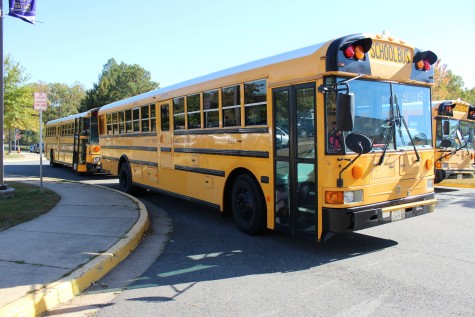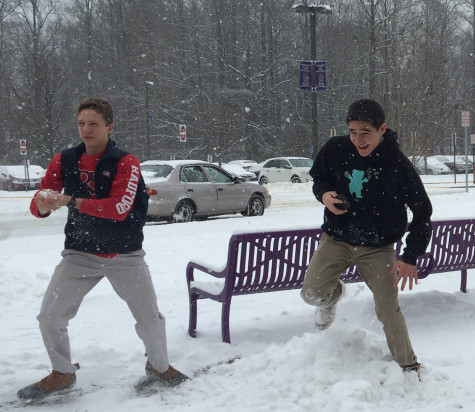Change to Bruin Block ignites controversy
Photo by Andrew Clinton
Physics teacher Bill Meyers assists his students during a Wednesday free choice Bruin Block period.
The ring of students’ laughter echoes through the empty hallways as the bell rings. Students frantically run to their destinations while clutching all their heavy textbooks in their arms and hauling their massive backpacks on their shoulders. The sound of the bell fades away as the students quickly saunter into their classes with bitter frowns on their faces. It is the start of a brand new year, with many brand new changes. To the dismay of most of the students, one of those changes has caused a significantly greater impact than others: the assigned Bruin Block.
Bruin Block has become a trademark part of a student’s day. It is a much-loved period of time that many students have come to rely on; however, during the years it has gone through a multitude of changes. This year, the administration decided to change the Bruin Block schedule by assigning students’ locations. Students responded largely negatively to the changes, stirring dissent among the student body. However, their dissatisfaction was not enough to compel the administration to reassess their decision. During the summer, the school’s leaders met to discuss the changes they felt needed to be made in order to bring Bruin Block back to its original purpose: Allowing students to meet up with teachers in order to get the help they need.
“I do not think [the new Bruin Block] will improve my grades since I can’t always go to the subjects I need help on and make it a priority,” junior Leah Choe said.
Principal Dave Thomas said the reasons for the Bruin Block change include accountability for students, discipline and the problem of struggling students not attending the classes that they were assigned to go to during Bruin Block.
Thomas conducted an experiment at the end of last year to see if seniors would go to their assigned Bruin Block class. He picked 25 seniors who were assigned to a Bruin Block class that they needed help in, he said. When he went to the classes to see if the students were present, he found that only one student had actually attended their assigned location.
“I strongly dislike the new Bruin Block because it’s taking my own personal study time away,” Choe said. “I have to work all my extra help and tutoring hours around a single Bruin Block rather than five.”
The disciplinary issues that Thomas spoke of are security issues as well. Students were leaving school grounds and doing things that they shouldn’t be doing, or things that could get them in trouble with the law, Thomas said.
If students need to meet with other teachers, they have the flex-out option. The flex-out works when a student needs to attend another class during an assigned Bruin Block. The teacher who the student needs to go to has to email the teacher that the student is supposed to go to, and if both teachers agree, then the student will be able to go to the other class.
“If [teachers] have specific kids that you need to get to your class, it’s as simple as sending an email, and I even showed [teachers] a quick and dirty way to generate an email that they can send to teachers to say ‘Hey, I need this student in my class on these days,’” Thomas said.
The last facet of the administration’s reasoning is the security of students. Thomas said that parents would call asking for their child, and the administration would have no idea where they were.
“The biggest thing I do as a principal is to make sure that [students] are safe,” Thomas said, “and I can’t make sure that all 4,000 students here are safe if I don’t know where you are.”
So far this year, the Bruin Block change has received a mixture of good and bad responses. The administration’s goal is to have a Bruin Block that has a little more structure than last year’s Bruin Block. Staff meetings were held where teachers were informed of the administration’s vision for what Bruin Block is supposed to look like, Thomas said. The teachers are adjusting to the change along with the students.
“I think that the students that are prone to doing work in Bruin Block are the same students that did work last year during Bruin Block,” AP Language teacher Julie Evans said.
On the whole, students seem to be very against the new Bruin Block. According to a survey done by The Bear Facts, 99 percent out of 250 students surveyed are against the change. The eight people in favor are generally freshman who have had assigned locations for the past two years in middle school, so the change is not new. The others in favor simply don’t have much of an opinion, or they have similar beliefs to the administration.
“The harsh reality is: You’re not always going to get what you want. We prioritize safety over free choice,” junior Omar Elhaj said. “We should be thankful that we get Bruin Block—students still have the ability to do whatever they want. Students just want to go places and talk. The entire point of Bruin Block is to work, so students get what they want.”
Choe, however still sees fault in the new system.
“There are a lot of drawbacks, such as not being able to go to my class that I struggle with and not being able to tutor people for various honor societies and clubs especially because not everyone has time after school [to see teachers],” Choe said.
Whether students like it or not, the administration is not planning on making any changes to the Bruin Block system any time soon.





